Precedence Diagram
- 1: What is Precedence Diagramming Method?
- 2: Purpose and Benefit
- 3: Types of Precedence Diagramming Method Relationships
- 4: Types of Dependencies in Precedence Diagramming Method
- 5: Application of Precedence Diagram
- 6: What to do before Create the Precedence Diagramming Method (PDM)?
- 7: How to Make Precedence Diagram
- 8: Examples of Precedence Diagram
With several advanced responsibilities concerned with handling a project, Project Management as a task has become even additional challenging. At the point when you decide the succession of steps in a project. It would be best to focus on the conditions between these steps that you will be taking in the project. A few steps may require archetype or replacement activities to be finished or begun before they can be started or finished themselves.
With tools to help that helps accomplish the project and death penalty duties, and supporting software, the widely used network techniques are over 0.5 a century old. Thus, project managers ought to think about techniques or ways that best suit their management style. This article outlines the Precedence Diagram and a way to draw & produce the Precedence Diagramming Method in Project Management.
1: What is Precedence Diagramming Method?
A strategy for scheduling steps in a task plan, the Precedence Diagramming Method (PDM), is an approach for building up a project schedule network diagram that uses nodes to address tasks and connects them with shots representing the dependencies. This precedence diagram is similarly called the activity-on-node (AON).
The method includes identifying and representing the grouping and dependencies of exercises in an undertaking or a piece of a venture, for example, a workstream or a working bundle.
The model can reflect four kinds of dependencies – likewise alluded to as intelligent connections – presented in the following article. These dependencies structure the association between successor tasks and archetype tasks that appear as nodes in the outline. This is like the activity-on-node or activity-on arrow method yet more adaptable as it permits covers of functions in the precedence diagram,
2: Purpose and Benefit
- Feature’s connections and dependencies among activities to guarantee arranging productivity.
- Distinguishes conceivable missing activities.
- Distinguishes basic exercises to guarantee better arranging.
- Builds up the general venture plan.
- A tremendous specialized instrument for project colleagues
- It assists you with discovering connections and dependencies among activities.
- This aids you in arranging and keeping away from hazards. On the off chance that any errand is missing, you can, without much of a stretch, recognize it.
- You can discover basic exercises and spotlight them. Any deferral in basic activities will postpone your timetable.
- A task plan network graph is a decent specialized apparatus. ners can envision activities and comprehend the timetable.
- Without the Precedence Diagram, you can't build up your task plan.
3: Types of Precedence Diagramming Method Relationships
To understand how the Precedence Diagramming Method works, one must understand the types of Precedence diagramming method relationships and how it works. There are mainly four types of Precedence diagram, which are defined as below.
Finish-to-start (FS) relationship
This type of Precedence diagramming method is the most common method that is being used for Dependency in many forms of activities. The finish-to-start relationship is an activity that would not start before its predecessor's activity ends. If this is how the method works, then the dependency relationship among both activities is known as a finish to start. The best example of finish to start a relationship is a building, and how one cannot paint the building before it's wholly made, these two activities are joined. They can only be done after the first activity is finished.
Start-to-Start (SS) relationship
This type of Precedence diagramming method is when both activities start concurrently, which means simultaneously or together. One example of the start-to-start relationship is a database design that was quickly be created parallelly with the design of the screen. In the case of the start-to-start relationship, every activity that is done in this Precedence diagramming method is seen to be highly start-to-start dependent.
Finish-to-finish (FF) relationship
In this particular type of Precedence diagramming method, the activities or tasks need to be completed together. The primary example of a finished relationship would be the project testing task. The task for the bug fixings needs to be assembled to function correctly in the software development stage. The software can never work correctly if testing is done before the bug fixing, and bug fixing cannot be completed without the bug fixing as it needs to be done by testing. They need to be assembled. This is one of the best examples for this Precedence diagramming method type.
Start-to-finish (SF) relationship
This is one of the rare types of activity projects in the precedence diagram method. In this relationship method, the second activity can only complete after the start of the first activity. This type of relationship can also be used in the chain just in time. An example of the beginning-to-finish relationship would be a house. One possibly cannot leave their last house and move into their new home.
4: Types of Dependencies in Precedence Diagramming Method
The Precedence diagramming method uses four types of dependencies:
- Mandatory Dependency
- Discretionary Dependency
- External Dependency
- Internal Dependency
This type of Dependency is the most commonly used out of all the four types of Dependency. Required Dependency is also recognized as complex logic that means it is challenging to avoid. That means the next activity that you will be starting is depending on it. To simplify it, one activity cannot begin till your predecessor activity is completed. The most common example for this can be a ceiling, and a roof cannot be installed until all the walls have been built.
It is also commonly recognized as soft logic or preferential logic. This type of Dependency plays a considerable role when it comes to optimizing resources that are managed by the project team. In discretionary Dependency, the activities are done in the preferred logic that is beneficial. For example, if constructing the four walls might have been more helpful in a specific sequence, you will build those walls in the helpful series. That means the order can be changed according to the benefits, but the activity would remain.
In this type of Dependency, the project management team does not have any say because it comes from outside of the project. The best example of external Dependency is government approval, as you would not be able to do any activity without the government's permission.
This kind of Dependency is the method that involves the project activities in this precedence relationship. For example, if one team member from the project team is assigned a new task, he cannot start working on it before the previous project is completed, no matter if there is a mandatory dependency.
5: Application of Precedence Diagram
The purpose of Precedence Matrix is to help people to decide project precedence according to weight and decisive relevance. Once we recognize the relevance and options via Relationship Matrix, Association Diagram, Tree Diagram etc., we'll enter into decision-making stage.
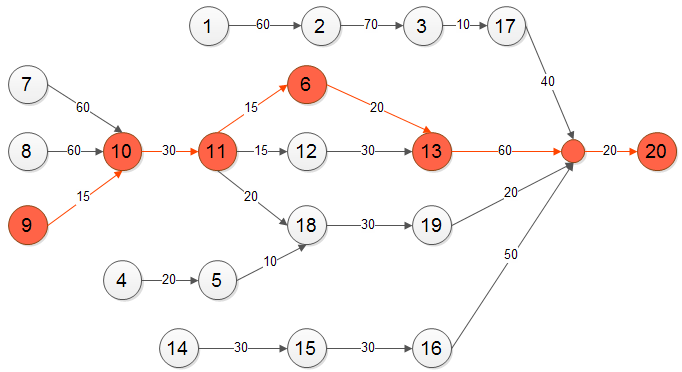
Two factors are needed in Precedence Diagram:
(1) Decision-making principles
depending on our understanding of important matters. e.g.: Economy, time, physical performance and service form made up basic catalogues of decision-making principles.
(2) Comparative method in relevance.
In subjective evaluation, with everyone's past experience and understanding of future, they collectively follow agreeing / voting / basic queuing process. Method includes Delphli method--sequence / voting plan, Nominal Group Technique (NGT) and so on.
In objective evaluation, we specify relevant weight value and calculate this values to a relatively prior number. The Analytic Hierarchy process (AHP) is a widely used quantification technique.
6: What to do before Create the Precedence Diagramming Method (PDM)?
Creating a Precedence Diagram is an essential step in any work and its planning in the work breakdown structure. When you correctly use the planning of the project with diagramming to break down the tasks and activities in certain groups. To complete the project before the deadline, you must know the fundamental capacities and the correct order in which the assignment can be done on time. To make the task easier, we should create the Precedence diagramming method.
So, to make that, there are some of the basic steps you need to follow to make a perfect diagram which is as follows:
- First, get a chart paper or find a whiteboard so you can draw your plan on it. Then, start writing the top priority work from your WBS on the right side of your chart paper or whiteboard.
- Write every work from your breakdown structure and set the work in the order when it needs to be delivered.
- Work till you have the dependencies between your activities and the function of the sequence that is running side by side.
7: How to Make Precedence Diagram
Making a precedence diagram is not hard anymore because of EdrawMax. one can easily create a Precedence diagram method without giving it hours. All you have to do is download EdrawMax or go to their website and make one there. It's as easy as it sounds. To make it easier, the following are the steps on how to create the Precedence diagramming method.
Step 1: Install EdrawMax
Go to the official website of EdrawMax and download the software.
Step 2: Now, create various sizes of shapes, forms and grids according to your activity.
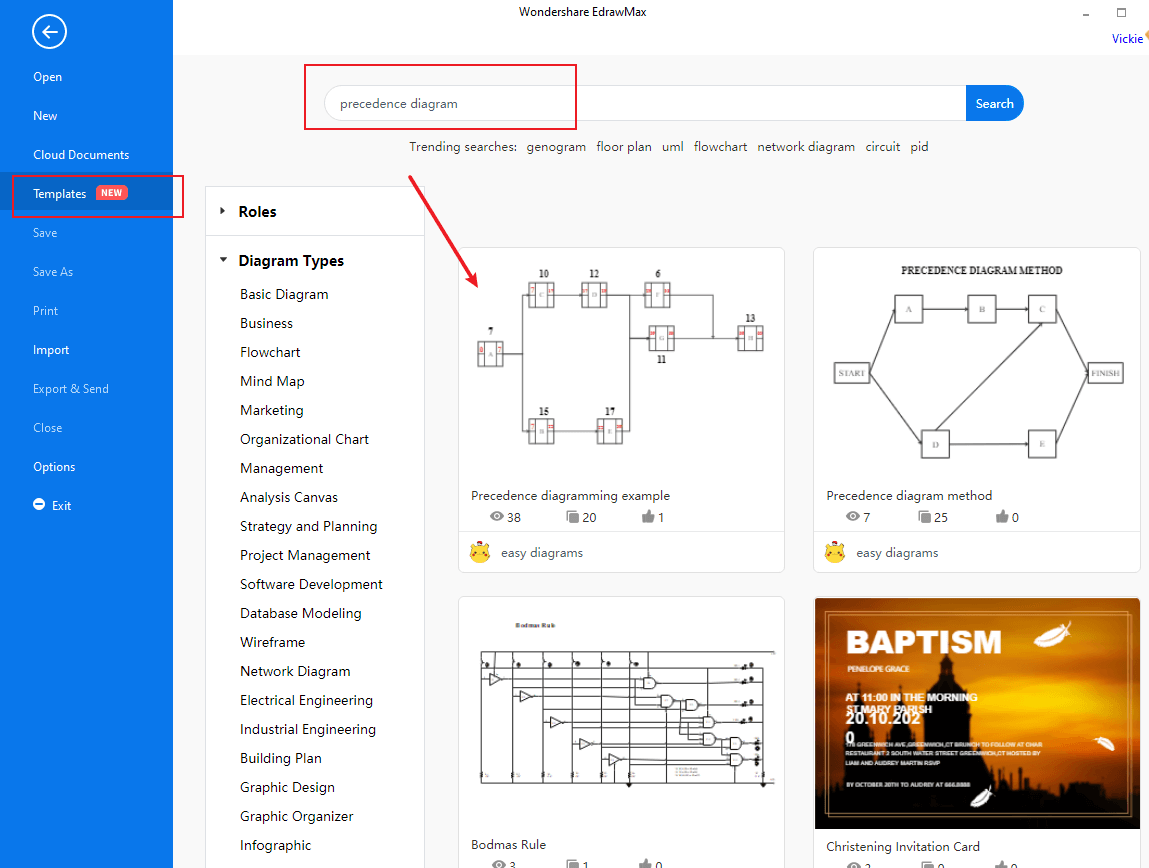
Step 3: Now comes the designing part of the diagram. You can colour your boxes and choose the design from various options given on the EdrawMax website according to your given criteria for the precedence diagram.
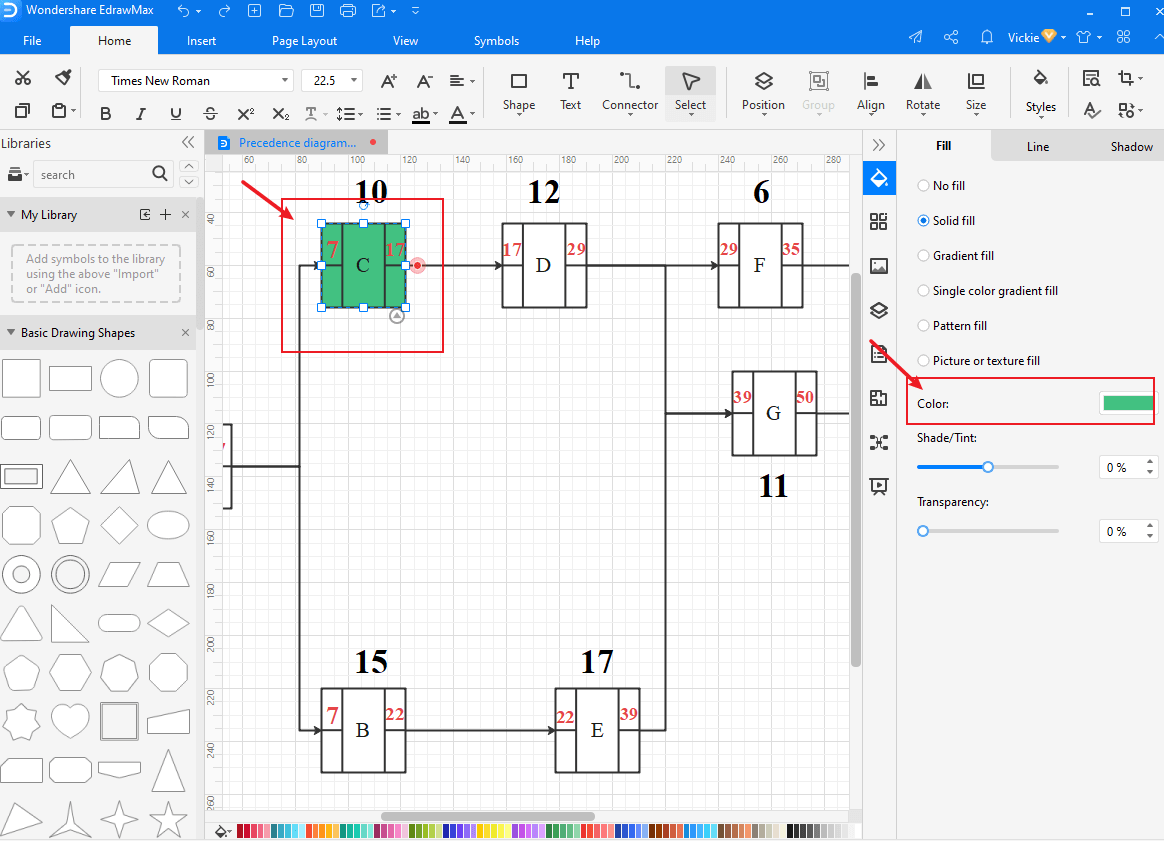
Step 4: Now your diagram is done, all you have to do is save your precedence diagram and click on export. Choose the place to save your chart in any form, be it graphic, HTML, PDF etc.
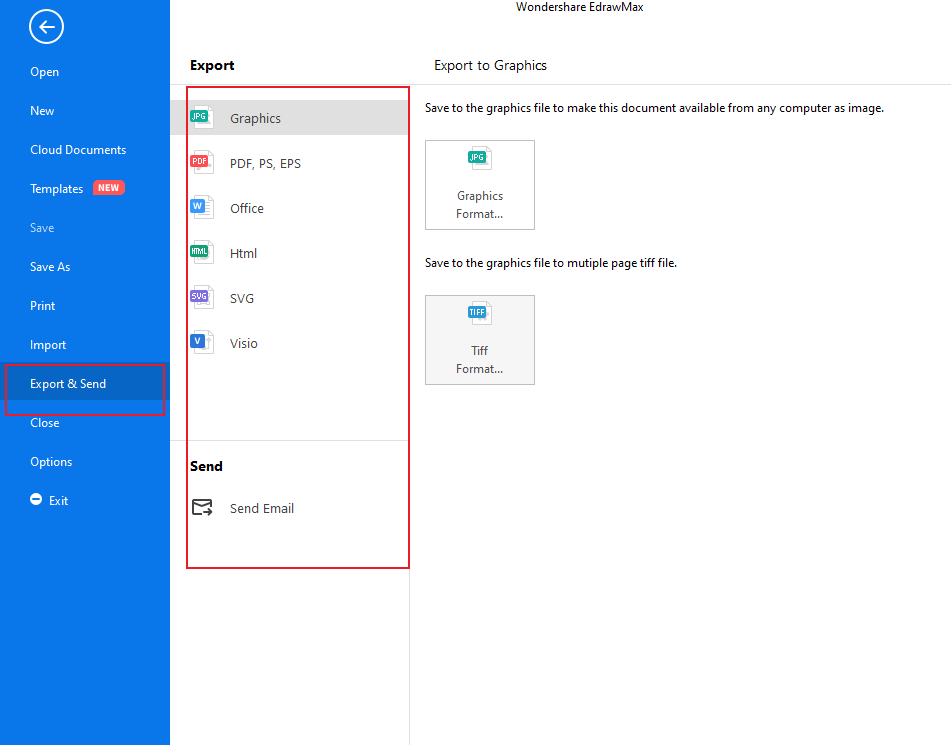
EdrawMax
All-in-One Diagram Software
- Superior file compatibility: Import and export drawings to various file formats, such as Visio
- Cross-platform supported (Windows, Mac, Linux, Web, Android, iOS)
8: Examples of Precedence Diagram
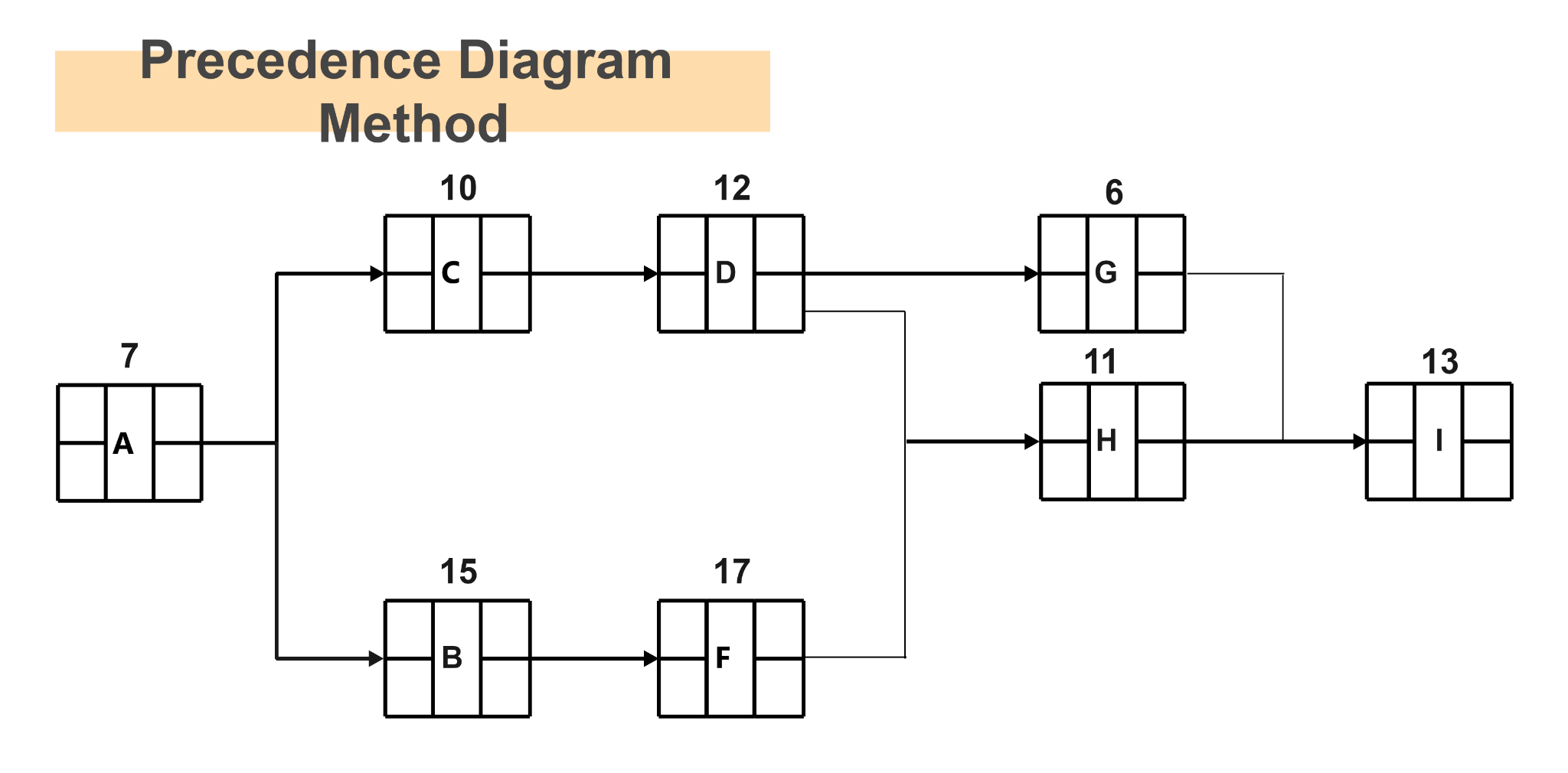
The above example is of the Precedence Diagram Method. The activity is represented from the A to H, and the numbers in this precedence diagram denote the core module of the precedence diagram method.



